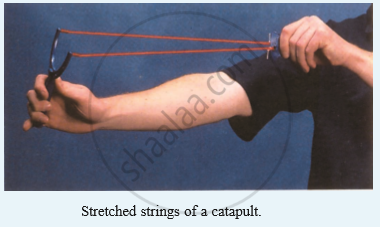Advertisements
Advertisements
प्रश्न
An automobile engine propels a 1000 kg car (A) along a levelled road at a speed of 36 km h–1. Find the power if the opposing frictional force is 100 N. Now, suppose after travelling a distance of 200 m, this car collides with another stationary car (B) of the same mass and comes to rest. Let its engine also stop at the same time. Now the car (B) starts moving on the same level road without getting its engine started. Find the speed of the car (B) just after the collision.
उत्तर
Here, mass of the car A, mA = 1000 kg
Initial speed of the car A, uA = 36 km h_1
= `36 xx 5/18`
= 10m s−1
Opposing frictional force, F = 100 N
∴ Power of the engine of car A
= F µA = (100 N) × (10 m s−1) = 1000 W
When car A collides with car B of mass 1000 kg,
Final speed of car A, vA = 0
Initial speed of car B, uB = 0
Applying conservation of momentum, P, = P,
mAvA + mBuB = mAvA + mBvB
1000 × 10 + 1000 x 0 = 1000 × o + 1000 × vB
∴ vB = 10m s−1
So, the speed of the car B just after the collision is 10m s−1
APPEARS IN
संबंधित प्रश्न
A pendulum is oscillating on either side of its rest position. The correct statement is:
A metal ball of mass 2 kg is allowed to fall freely from rest from a height of 5 m above the ground. Taking g = 10 m s-2, calculate:
- the potential energy possessed by the ball when it is initially at rest.
- the kinetic energy of the ball just before it hits the ground?
State whether the object possess kinetic energy, potential energy, or both :
A man climbing a hill _____________.
What kind of energy is possessed by the following?
A running car ____________
What kind of energy is possessed by the following?
Water stored in the reservoir of a dam __________.
What type of energy is possessed : by the piece of stone which is thrown away on releasing the stretched rubber strings of catapult?
A ball of mass 0.5 kg slows down from a speed of 5 m/s so that of 3 m/s. Calculate the change in kinetic energy of the ball. State your answer giving proper units.
How much electric energy in kWh is consumed by an electrical appliance of 1000 watts when it is switched on for 60 minutes?
Name the energy transfers which occur when : there is a picture on a television screen
A ball falls to the ground as shown below :
What is the potential energy of ball at B?
